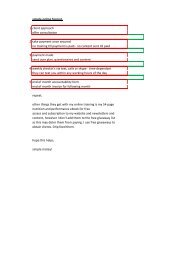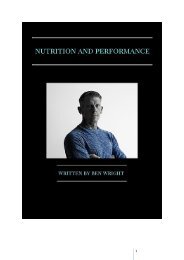Create successful ePaper yourself
Turn your PDF publications into a flip-book with our unique Google optimized e-Paper software.
Below I have bullet pointed how you shall start to calculate your reverse diet:<br />
<br />
<br />
<br />
<br />
<br />
<br />
<br />
<br />
Calculate your current calorie intake by tracking food on your app – my fitness pal – for a<br />
few days.<br />
I recommend that you get 1g of protein per 1lb of body weight. So, if you weigh 160lbs then<br />
you will start with 160g of protein.<br />
To gauge the fat intake simply multiply the daily calories by 0.3 for example if you’re on<br />
1600Kcal a day then the answer would be 1600 x 0.3 = 480. Now because there is 9 Kcals in<br />
1g of fat we divide the answer by nine so, 480/9 = 53. Therefore, your fats will be set at 53g<br />
per day.<br />
Carbs will make up the remaining Kcals. 4 calories to 1g of carbs.<br />
In my fitness pal, you have the option to adjust all these settings. If you have any issues, then<br />
contact myself <strong>and</strong> we can do it together.<br />
Increase calories daily by small amount of no more than 50 – 100 Kcal a week to start with,<br />
until you’re up to your maintenance level.<br />
Weigh yourself each week to track the weight. When it plateaus then increase those calories<br />
some more, by very small amounts within that 50 – 100 kcal range.<br />
Training should be weight <strong>and</strong> resistance based whilst reverse dieting because weight<br />
training helps to speed up the metabolism. Also, helping to significantly benefit body<br />
composition.<br />
So, we have a set calorie target base <strong>and</strong> we have figured out what our macros are. Now we just<br />
need to start to slowly increase the calories weekly by no more than 50 - 100Kcals a week to start<br />
with. As the metabolism catches up we can start to increase the calories again.<br />
I know I have stated above to weigh yourself, but don’t get overly fixated on the scales. Daily stress<br />
levels, water retention, the gut etc. can play a part in weight each day by a pound here <strong>and</strong> there.<br />
Simply use the scales to observe your weight throughout the process. One way I find useful is to<br />
weigh yourself each day. At the end of the week add up the seven days’ weight then divide by seven<br />
for an average. Do this each week <strong>and</strong> compare to the previous week. Also, recording in my fitness<br />
pal will show you a scale of weight <strong>and</strong> the progress. Also, remember what you see in the mirror is a<br />
great way to record progress.<br />
How do you know when to stop the reverse diet?<br />
When you have achieved a manageable calorie intake without putting on more unwanted fat <strong>and</strong><br />
you can maintain a desired weight <strong>and</strong> body composition.<br />
If you were overweight at the start, simply by training <strong>and</strong> doing the reverse diet correctly you would<br />
have lost weight whilst increasing your calories….<br />
The human body is an amazing thing!!<br />
By the end of reverse dieting you should have a working metabolism <strong>and</strong> a functioning hormonal<br />
system. You should be feeling great. And no more Yo-Yo dieting will be necessary.<br />
21




